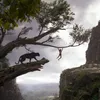[Sustainability] From corridors of uncertainty to safe passages
Ecological corridors are essential to conserve biodiversity and ecosystems. Loss of corridors would mean loss of connectivity for most species
Susan Morse of the US Fish and Wildlife Service wrote that “whether they run, swim or fly, wild animals need to move to complete their life cycles. We call their routes wildlife corridors. These can span anywhere from a stretch of river to a whole continent.”
Essentially, it is an area used by wild animals to move from one place to another. A genetic study by the Wildlife Conservation Trust found that tigers move over 700 km in one generation, making the areas between the two distant forests critical for the species to survive. Corridors are not just for large animals, but even small creatures from all taxa have their corridors, be it salmon or striped tiger, butterflies or frogs, that move across or within a landscape. Thus, corridors are not necessarily patches of forests, they could range from stream beds, agricultural lands, wooded areas to even roads. It is about the function and the form.

A tiger in Pench, where the first wildlife underpass was built on NH 44, which bisects the Kanha-Pench corridor.
Image: Rahul Deshmukh/Unsplash
Why are corridors important?
Ecological corridors are indispensable to conserving biodiversity and the functioning of ecosystems. Loss of corridors would mean loss of connectivity for most species due to restricted or lack of access to the habitats needed for their life cycles.
Without corridors, the movement of the species would not be possible and thus it would negatively impact the overall functioning of the ecosystems, which in the long run would collapse the life-supporting services such as climate regulation, provisioning services, water security, carbon storage, etc that we receive from them.
How do corridors get destroyed?
Corridors for lesser-known species especially the herpetofauna – fish and small mammals – are lost due to a lack of understanding, and no measures taken to maintain them. Many linear infrastructure projects such as roads, railways, canals, and powerlines cut across large landscapes segmenting the ecosystems, thus destroying connectivity for the large fauna. Mines, reclamation projects, fenced farms, and other developmental activities when situated in corridors completely destroy them.
Should no projects be allowed in corridors?
There is enough scientific knowledge to ensure that neither development nor ecological corridors get negatively impacted. We can plan linear infrastructure projects better by ensuring that these do not pass through ecologically sensitive areas, which is possible in many cases. Where there are no options, mitigation measures such as underpasses should be put in place. This should cover most projects; only in exceptional cases, projects might have to be stalled looking at the ecological and economic cost-benefit ratios.

Deer are frequently seen on the main highway that crosses Bandipur park in Karnataka
Image: Saket Upadhay/Unsplash
What are the ways to protect corridors without affecting development?
There are several studies published by various organisations on the wildlife corridors of India such as Right to Passage: elephant corridors of India by Wildlife Trust of India (WTI), papers published by WWF-India, and various state forest departments that have formally identified corridors. Yet, it is ironic how little is done for their conservation. The law does not explicitly define corridors along with the importance of national parks or sanctuaries.
However, some favourable judicial judgements have been passed. The first wildlife underpasses were built on NH 44, which bisects the Kanha-Pench corridor. It has been observed that several large wild animals use these underpasses. Researchers have come up with design concepts for small-sized animals that can be easily incorporated into developmental projects with negligible costs.
Today, conservation and maintenance of ecological corridors is more a matter of will than feasibility. As a country, we need to delineate ecological corridors across landscapes and aquatic scapes. If any of the developmental projects lie or pass through these delineated areas, such projects should undergo an ecological and economic cost-benefit analysis. Wherever feasible, such projects should be re-aligned or moved.
In other cases, mitigation measures should be put in place at the budgeting phase itself. The recent allocations of two percent for mitigation measures, need to be revisited and necessary changes need to be made so as to ensure that mitigation measures are effective. This can ensure that ecological corridors and the functioning of our ecosystems are not disturbed. The future of corridors need not be uncertain.
Edited by Diya Koshy George

![[Sustainability] From corridors of uncertainty to safe passages](https://images.yourstory.com/cs/5/f5a7f3304b1211e9b6645b8ae897d03e/Imagep6f7-1649845969690.jpg?mode=crop&crop=faces&ar=2%3A1&format=auto&w=1920&q=75)






